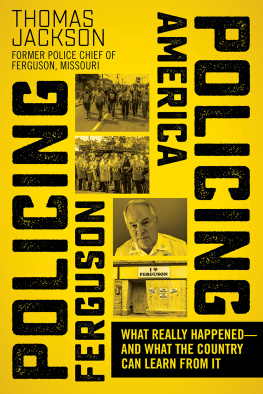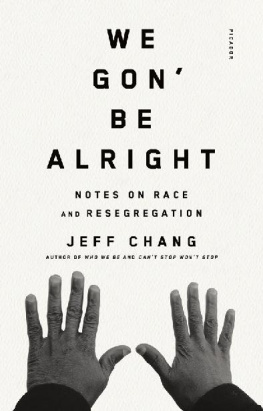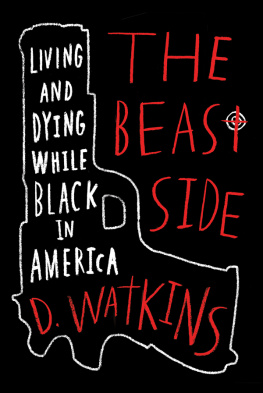HANDS UP, DONT SHOOT
Hands Up, Dont Shoot
Why the Protests in Ferguson and Baltimore Matter, and How They Changed America
Jennifer E. Cobbina
NEW YORK UNIVERSITY PRESS
New York
NEW YORK UNIVERSITY PRESS
New York
www.nyupress.org
2019 by New York University
All rights reserved
builds upon material previously published as Jennifer E. Cobbina, Soma Chaudhuri, Victor M. Rios, and Michael Conteh, I Will Be Out There Every Day Strong! Protest Policing and Future Activism among Ferguson and Baltimore Protestors, Sociological Forum 34, no. 1 (March 2019). Copyright and reprinted here with permission from Eastern Sociological Society.
References to Internet websites (URLs) were accurate at the time of writing. Neither the author nor New York University Press is responsible for URLs that may have expired or changed since the manuscript was prepared.
Library of Congress Cataloging-in-Publication Data
Names: Cobbina, Jennifer E., author.
Title: Hands up, dont shoot : why the protests in Ferguson and Baltimore matter, and how they changed America / by Jennifer E. Cobbina.
Description: New York : New York University Press, [2019] | Includes bibliographical references and index.
Identifiers: LCCN 2018044999| ISBN 9781479818563 (cl : alk. paper) | ISBN 9781479874415 (pb : alk. paper)
Subjects: LCSH: Police brutalityMissouriFerguson. | Police brutalityMarylandBaltimore. | African American menViolence against. | Discrimination in criminal justice administrationUnited States. | Police-community relationsUnited States. | Protest movementsUnited States. | United StatesRace relations.
Classification: LCC HV 8141 . C 56 2019 | DDC 363.2/32dc23
LC record available at https://lccn.loc.gov/2018044999
New York University Press books are printed on acid-free paper, and their binding materials are chosen for strength and durability. We strive to use environmentally responsible suppliers and materials to the greatest extent possible in publishing our books.
Manufactured in the United States of America
10 9 8 7 6 5 4 3 2 1
Also available as an ebook
CONTENTS
PREFACE
After the killing of Michael Brown and the protests in Ferguson, Missouri, I, like many others, found myself glued to the television as I watched the story and the reaction to his death unfold. What happened in Ferguson felt personal to me. I had lived a couple of minutes from the city while pursuing my doctorate from 2004 to 2009. Thus, when Victor Rios, a colleague of mine who has done important work on policing kids, sent out an email asking if any scholars wanted to go to Ferguson to interview protesters, I jumped at the chance. Several criminologists and sociologists soon formed the Ferguson Research-Action Collaborative with the goal of studying protests and the Black Lives Matter movement. We also hoped to contribute to the struggle for racial justice in the United States.
The group talked about meeting up in October 2014 and also attending the National Day of Protest against Police Brutality. One of the local sociologists had been engaged in Ferguson protest events since early August and informed us that if we attended the protest we had to prepare for the possibility of arrest. At that time, police were arresting large numbers of protesters. We were encouraged by this local sociologist to stay on the sidewalk, wear running shoes, and write the phone number for jail support on our arms in case we were arrested and needed legal assistance. I started to grow concerned. The response from state police was also mind-boggling. I watched on CNN the various police tactics used to repress collective action on the streets, including tear gas, Long-Range Acoustic Riot Control Devices (LRAD), military-style armored tactical vehicles, police dogs, and lines of riot-geared officers. I began asking myself: Will it be safe for me to do this research? As a Black woman, I could be seen as a potential target for police.
With the strong desire to pursue this study but with uncertainty looming, I called my former pastor, Bishop Jesse Battle, whom I trust and respect, and who lived in St. Louis. I explained my desire to come to Ferguson to interview residents and protesters. But, I told him, Im a bit scared. Do you think its safe? As someone who was in the trenches and spoke out boldly against the racial injustices that were going on, he encouraged me to come. When I told him of my desire to attend the National Day of Protest against Police Brutality simply to observe, he acknowledged that I may very well be arrested just for attending. I was a bit baffled since I didnt plan on doing anything but observe the protest unfold. He told me that around that time people were getting arrested just for stepping off the sidewalk. If one happens to stay during a time police tell people to disperse, one may be arrested. He, too, confirmed the importance of wearing running shoes and writing the number for jail support on my arm. Should I come to Ferguson given the risks? I asked him. He responded, Jennifer, just come. With that said, I made up my mind and went.
Introduction
On August 9, 2014, Darren Wilson, a White officer of the Ferguson Police Department (FPD), saw two young Black men, eighteen-year-old Michael Brown and his friend, twenty-two-year-old Dorian Johnson, walking in the middle of the street on Canfield Drive in Ferguson, Missouri. Ferguson is a small suburb of St. Louis where Blacks comprise 67 percent of the population. Brown punched him and reached for his gun, and a struggle for the weapon ensued, during which Wilson fired two shots, one of which stuck Brown in the hand. The DOJ concluded that, after the shooting inside the vehicle, Brown ran and Wilson chased him and shot him after he turned around and charged at him. In total, Wilson fired twelve bullets, six of which hit Brown, two of them in the head.
Though several witnesses asserted that Brown had his hands up in an act of surrender before Wilson shot him to death, the DOJpointing to changing statementsdetermined that these accounts were inconsistent with physical and forensic evidence. The former St. Louis County Prosecutor Robert McCullough, who many protesters argued had deep ties to the police and should recuse himself, brought the case in front of a grand jury to determine whether there was probable cause to indict On November 24, 2014, McCullough announced that the grand jury had decided not to indict. In the wake of several high-profile deaths of other Black men, including Trayvon Martin, Eric Garner, and John Crawford, the case received national attention and the grand jury announcement sparked civil unrest across the country, including in Los Angeles, New York, Seattle, Philadelphia, and Chicago. Marie, a Latina protester in Ferguson, detailed her experience protesting immediately after the fatal shooting of Brown:
We were at the police station protesting, and the police were out there in mass with dogs. And there was a woman, and she was yelling at this line of police, saying, you know, What if this was your child? What if this was your child? And then that night like twenty-four hours after Mike Brown was shot, a little bit more than twenty-four hours, we went on West Florissant and there wereand Im not exaggerating, like Ive never seen that many copsthree hundred police in full riot gear. And I dont scare easy, but it was one of the moments in my life where I was scared because what I saw was these police, this massive police presence. And I saw unseasoned, angry, primarily young Black kids just angry and trying like some of them were throwing bottlesand then I saw the cops with their riot gear ready to engage. And I got in the middle of that. I had held the line for three hours, where I had my back to the police officers and my face to the young people. They were righteously mad. They had a right to protest. And when the looting startedand it didwe had to break the line to trybecause there wasnt enough elders out there. There wasnt, it was all young people. We had to break the line to go and try and stop the looters. [After] QuikTrip burned down thats like when it started to happen, and then it was just like tanks and rubber bullets. And theyre teargassing the streets. police [were] advancing on us in full riot gear. Police [were] advancing on us with shotguns.







